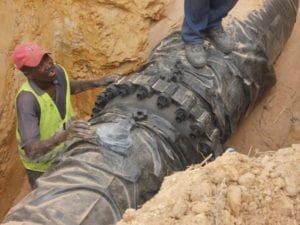Construction of Phases 1 and 2 of the Swartland Bulk Water Pipeline in Gouda, Western Cape, commenced in May last year and has reached the final stages with an estimated completion date of mid-2013, Ehrane Holderness, UWP Consulting principal engineer, recently told Chantelle Mattheus.
According to Holderness, the project’s background is fairly simple. A 525 mm Nominal Diameter (ND) steel pipeline currently runs between the Swartland Water Treatment Works at Voëlvlei Dam and the Kasteelberg Reservoirs at Riebeek West. “The pipeline was constructed in the 1970s and is the main bulk water supply line for seven towns in the Swartland municipal area. The West Coast District Municipality’s 2010 Water Master Plan identified the need for an additional parallel pipeline to meet future water requirements, mitigate the risk associated with having a single bulk supply line and to allow downtime for maintenance work on the existing pipeline,” says Holderness. The five municipalities falling under the WestCoast District Municipality are:
- Swartland Municipality with Malmesbury as administrative centre
- Bergrivier Municipality with Piketberg as administrative centre
- Matzikama Municipality with Vredendal as administrative centre
- Cederberg Municipality with Clanwilliam as administrative centre
- Saldanha Bay Municipality with Vredenburg as administrative centre.
Additionally, the pipeline route runs mainly across private agricultural land and construction access had to be negotiated with land owners. “Although affected parties were very forthcoming in this regard, careful planning around the movement of construction vehicles was required during harvesting periods,” says Holderness.
At the project’s peak, approximately 35 workers were on-site, including of operators and supervisory staff. Differentiating factors According to Holderness, what makes this project different is the use of ductile iron pipes for the low-pressure zones and continuously welded steel pipes in the high-pressure zones. “Ductile iron was the preferred material from a financial point of view. However, continuously welded steel pipe was used in the high pressure zones as insufficient space was available in the servitude for the thrust blocks associated with ductile iron pipes.” In addition, phasing of the project was required in line with the availability of municipal funds. “During Phase 1, 8 450 m of standard 600 mm ND Class K9 ductile iron pipes were ordered in advance. Phase 2, which will be completed in June 2013, entails the construction of 2 650 m of continuously welded 600 mm ND steel pipe and 9 050 m of 600 mm ND ductile iron pipe, of which 600 m was manufactured with restraining joints,” adds Holderness. Phase 3 of the project will commence in 2014 and will entail the supply and construction of 2 600 m of 600 mm ND steel pipe and 1 900 m of 600 mm ND Class 30 ductile iron pipe. However, the design for the entire project was completed prior to Phase 2 commencing, says Holderness. Challenging context Although the civil engineering aspects of the project are fairly straightforward, with no new technologies, processes or procedures really being implemented, this does not mean the project has been without its challenges. According to Holderness, these included difficult accessibility to the site via informal dirt roads, which is exacerbated by wet conditions during the Western Cape rainy season. In addition, all construction activities such as stringing of pipes, excavation and storing of the topsoil for reuse had to be accommodated on a narrow servitude, and commercial bedding and ready-mix concrete had to be transported through private farmlands. “The highlight will be the successful completion of the interconnecting chambers and successful hydrostatic pressure testing of all the installations,” concludes Holderness.







